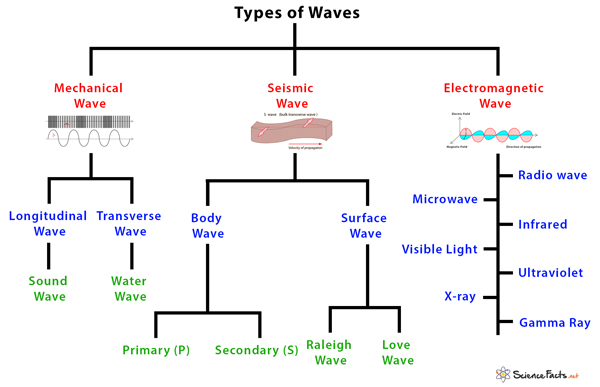Wave
A wave is a disturbance in a medium that carries energy without a net movement of particles. It may take the form of elastic deformation, a variation of pressure, electric or magnetic intensity, electric potential, or temperature.
Introduction of Waves
- Transfers energy.
- Usually involves a periodic, repetitive Movement.
- Does not result in a net movement of the medium or particles in the medium (mechanical wave).
Wave
There are some basic descriptors of a wave. Wavelength is the distance between an identical part of the wave. Amplitude is the maximum displacement from the neutral position. This represents the energy of the wave. Greater amplitude carries greater energy. Displacement is the position of a particular point in the medium as it moves as the wave passes. Maximum displacement is the amplitude of the wave
Frequency (ƒ) is the number of repetitions per second in Hz, s -1 Period (T) is the time for one wavelength to pass a point. T = ƒ-1
The velocity (v) of the wave is the speed that a specific part of the wave passes a point. The speed of a light wave is c.
Types of Waves:
1. Transverse Waves
Waves in which the medium moves at right angles to the direction of the wave.
Examples of transverse waves:
- Water waves (ripples of gravity waves, not sound through water)
- Light waves
- S-wave earthquake waves
- Stringed instruments
- Torsion wave
- The high point of a transverse wave is a crest. The low part is a trough.
2. Longitudinal Wave:
A longitudinal wave has the movement of the particles in the medium in the same dimension as the direction of movement of the wave.
Examples of longitudinal waves:
- Sound waves
- P-type earthquake waves
- Compression wave
- Parts of longitudinal waves:
Compression: where the particles are close together.
Rarefaction: where the particles are spread apart.
Electromagnetic Waves: Radio signals, light rays, x-rays, and cosmic rays.
Mechanical waves: A wave which needs a medium in order to propagate itself. Sound waves, waves in a Slinky, and water waves are all examples of this.
Matter Waves: Any moving object can be described as a wave When a stone is dropped into a pond, the water is disturbed from its equilibrium positions as the wave passes; it returns to its equilibrium position after the wave has passed.
Electromagnetic Waves: These waves are the disturbance that does not need any object medium for propagation and can easily travel through the vacuum. They are produced due to various magnetic and electric fields. The periodic changes that take place in magnetic electric fields and therefore known as Electromagnetic Wave
Electromagnetic-waves
Electromagnetic wave
Wave Speed Formula
It is the total distance covered by the wave in a given time period. The formula for wave speed is given as,
Wave Speed = Distance Covered/Time taken
Properties of Waves
The prime properties of waves are as follows:
Amplitude – Wave is an energy transport phenomenon. Amplitude is the height of the wave, usually measured in meters. It is directly related to the amount of energy carried by a wave.
Wavelength – The distance between identical points in the adjacent cycles of crests of a wave is called a wavelength. It is also measured in meters.
Period – The period of a wave is the time for a particle on a medium to make one complete vibrational cycle. As the period is time, hence is measured in units of time such as seconds or minutes.
Frequency – Frequency of a wave is the number of waves passing a point in a certain time. The unit of frequency is hertz (Hz) which is equal to one wave per second.
The period is the reciprocal of the frequency and vice versa.
Period=1Frequency
OR
Frequency=1Period
Speed – The speed of an object means how fast an object moves and is usually expressed as the distance travelled per time of travel. The speed of a wave refers to the distance travelled by a given point on the wave (crest) in a given interval of time. That is –
Speed=Distance/Time
Speed of a wave is thus measured in meter/second i.e. m/s.
